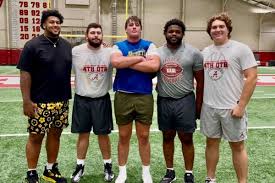The Detroit Lions are no longer the lovable underdogs or the punchline of NFL futility. Dan Campbell’s gritty squad has clawed its way into national relevance, and expectations for 2025 are sky-high. With a roster that boasts both emerging stars and hardened veterans, the Lions are no longer building for the future—they’re chasing championships now. But even the most complete teams have question marks. For Detroit, one of those revolves around a player who was once seen as a potential defensive cornerstone: their former third-round defensive lineman, who now finds himself on the hot seat.
The Lions believe in his talent. That’s never been the issue. What they’re waiting for is reliability—consistency in health, performance, and availability. With the team aiming for a deep playoff run in 2025, the time for development has passed. Now, it’s time to deliver.
A Promising Pick
When the Lions selected [Name], a defensive lineman out of [College], in the third round of the [Draft Year] NFL Draft, there was plenty of buzz. Blessed with raw power, nimble feet for a big man, and impressive college production, [Name] was seen as a high-upside player who could eventually anchor the defensive interior.
Scouts pointed to his versatility. At [Height] and [Weight], he had the mass to clog gaps and the burst to rush the passer from multiple alignments. In a league that increasingly values hybrid defenders capable of both stopping the run and pressuring quarterbacks, [Name] seemed like a gem.
Dan Campbell and GM Brad Holmes spoke glowingly about his “motor” and “attitude.” He was seen as a culture fit—gritty, hard-working, and with a chip on his shoulder. In a defensive scheme that thrives on physicality and relentless effort, he was supposed to thrive.
Early Flashes, Lingering Concerns
In his rookie season, [Name] showed flashes of potential. He recorded a couple of sacks, made some key stops, and had coaches praising his effort in practice. But even then, durability was a concern. He missed time with nagging injuries—nothing major, but enough to disrupt his development.
Year two saw more of the same: occasional glimpses of what he could be, sandwiched between stretches of inconsistency. At times, he seemed hesitant on the field, slow to diagnose plays or reluctant to unleash his power. Coaches attributed this to overthinking and trying to play “mistake-free,” which ironically made him less effective.
The team hoped that year three would be the turning point. Instead, injuries once again became a storyline. [Name] found himself in and out of the lineup, and when he did play, he struggled with leverage, pad level, and sustaining effort through four quarters. Defensive coordinator Aaron Glenn continued to publicly back him, but the leash was clearly shortening.
Why Reliability Matters Now
Heading into the 2025 season, the Lions are no longer patient rebuilders—they’re contenders. Jared Goff leads a potent offense, Aidan Hutchinson is blossoming into a premier edge rusher, and the secondary has been fortified. The defensive line, however, still needs depth and consistency in the trenches.
[Name] is penciled in as a rotational piece, possibly even a starter depending on camp performance. But what the Lions need from him isn’t potential anymore—they need productivity. They need reliability. With the physical grind of a 17-game schedule and postseason aspirations, the team can’t afford uncertainty up front.
The problem is that while [Name] has all the tools, his career so far has been defined more by what could be than what is. In today’s NFL, “upside” is a dangerous currency if it never materializes. And on a roster built to win now, excuses are running out.
The Competition is Heating Up
Part of the pressure on [Name] stems from the rising competition around him. The Lions have spent draft capital and free-agent dollars to solidify the defensive line. Recent additions—like veteran run-stuffer DJ Reader, emerging sophomore Brodric Martin, or high-upside rookies like [Rookie Name]—have shown flashes of immediate impact.
In training camp, eyes will be on this battle. While [Name] may enter as the incumbent, he no longer holds a monopoly on opportunity. Coaches won’t hesitate to go with whoever gives them the best chance to win—especially in critical third-down situations or short-yardage run stops.
And in a league where durability and dependability are as valued as pure talent, [Name] must prove that he’s more than a name on the depth chart. He needs to stay healthy, execute consistently, and bring energy every single week. Anything less, and he risks being phased out.
The Front Office’s Perspective
Brad Holmes, known for his keen eye in talent evaluation, has generally shown patience with young players. But even he knows that time is money in the NFL. Holmes has built this roster with a clear identity: smart, tough, reliable. And that’s exactly what he expects from his mid-round draft picks, especially ones now entering Year 4 of their careers.
The front office has quietly sent signals this offseason. They brought in veteran insurance, they extended key defenders, and they added pieces in the draft. It’s clear that they’re not counting solely on [Name] to take “the leap.” That puts the onus squarely on the player: perform or get left behind.
With the new crop of younger, hungrier players pushing hard in camp, this may be [Name]’s last real shot at carving out a significant role in Detroit.
The Player’s Perspective
To his credit, [Name] hasn’t shied away from the pressure. In media availability earlier this offseason, he acknowledged that he needs to be more consistent and available. He spoke candidly about improving his offseason training regimen, cleaning up his diet, and working with specialists to reduce soft-tissue injuries.
He’s also embraced the mental side of the game, spending more time in the film room and working with Hutchinson and Glenn on technique refinements. “I want to be the guy they can count on,” he said. “Not just someone with potential, but someone who shows up and does the job every time.”
There’s a maturity in his tone that wasn’t always present in previous years. Whether that translates to the field is another question, but the willingness to adapt and grow is a promising sign.
What the Coaches Need
From Dan Campbell’s perspective, every player has a role—if they earn it. He’s never been one to hand out jobs based on draft pedigree or media hype. And while he’s been publicly supportive of [Name], Campbell has also made it clear that reliability is the hallmark of any player in his system.
“You have to be available. You have to be accountable. And you have to be physical,” Campbell said in March when asked about defensive line depth. “We’ve got a bunch of guys who are chomping at the bit to prove they belong. That’s what makes us better.”
It’s not hard to read between the lines. [Name] has to prove he belongs—every practice, every rep, every snap. The opportunity is still there, but the window is narrowing.
A Make-or-Break Year
The reality of the NFL is that most players don’t get five years to figure it out. By year four, you either contribute or you’re replaced. For [Name], this is the make-or-break season. A strong performance could earn him a second contract in Detroit or elsewhere. A mediocre showing could end with him on the cut list come August.
The stakes couldn’t be higher. Detroit’s playoff window is open. The fans are ravenous. The ownership has bought in. Everything is aligned for a deep run. But depth is critical, and each cog in the machine has to function properly.
If [Name] can stay healthy, control the line of scrimmage, and consistently make plays in both phases of the game, he could become a breakout star on a loaded defense. But if old patterns resurface, he could find himself watching from the sideline as others seize his opportunity.



